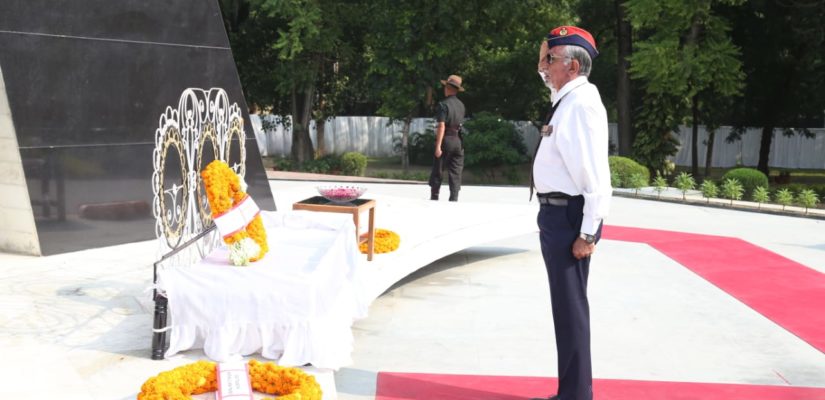
Army in service of the nation Salute the Soldier Army day 15 Jan 2019
Army in service of the nation Salute the Soldier Army day 15 Jan 2019
At the end of December, about 2500 tourists visiting Nathu La in Sikkim were stuck due the sudden inclement weather. They could neither move forward or return to Gangtok. They were stranded and had no option but to bear out the weather and possibly spend the night in freezing cold. The army, always the saviour in tough situations launched a massive rescue operation and moved all of them to safety into their own camp.
The camp had limited capacity and rations as also restricted clothing. However, the soldiers had large hearts, and they willingly shared whatever they had, accommodation, food, warm clothing and medical care to those whom they rescued. They sacrificed their comforts for their countrymen who needed it more than they did. This is another instance of the army being there for the country always.
The NDRF was created as an organization to be the first responder for disasters. The state created reserve police forces, while the centre raised and continues to raise Central Armed Police Forces (CAPFs) under multiple organizations for supporting the state in handling law and order. Despite all this, on almost every occasion the armed forces have landed up as the first responder.
Whenever all agencies fail, the government, either at the state or centre turn towards the army. The army as an institution has never failed the nation. Is this because of its discipline, ethos or dedication to the nation. Some major examples justifying this are appended.
In Sep 2010, just ten days before the commencement of the Commonwealth Games in New Delhi, the 164-foot-long footbridge collapsed outside Nehru Stadium, throwing the conduct of the opening ceremony into jeopardy. Parts of the bridge fell on the road leaving almost thirty workers injured. The army took over the job on 25th Sep, cleared the fallen debris and gave a Bailey Bridge to the organizers on 30th Sep, ensuring the event became a success.
In Feb 2017, an 18-year-old bridge at Enathu in Kollam district was closed to traffic after damages were noted in its piers. It threw traffic out of gear. The state government had no answer at its level. The army stepped in again and constructed a Bailey Bridge for the residents.
In the same state, when devastating floods hit in Aug 18, there was again the need for the army to step in and improvise. Army personnel from the Kannur Defence Security Corps Training centre, rushed and began improvising construction of almost 40-foot bridges using fallen trees, while simultaneously carrying out relief and rescue operations. These bridges became a life line and made rescue efforts easier. In all the army had constructed 13 such bridges.
The Sikkim earthquake of 2011 impacted all residents of the state, including army units deployed there. The orders passed by the General Officer Commanding the Sukhna Corps, responsible for the defence of Sikkim was simple. Leave your camps, move out in all directions, rescue all those who need help, open your barracks and messes and accommodate all who need food and shelter. Ignoring their own damages, the army moved in almost every direction. The NDRF moved in days later. The Governor remarked, with the army in the state, no other forces are required.
In the Srinagar floods of 2014, with their own cantonment, Badami Bagh submerged, the army was out on rescue and relief. Its own losses were to be handled last. They assisted all who needed help, moving serious patients to hospitals. They were rescuing those who were till the day before pelting them with stones and would recommence doing the same the very next day.
The latest was the construction of the three- foot overbridges by the army in Mumbai in Feb 2018. The Railways and the state failed in their task and the army was called in. It gave its deadline and worked within it, to create for the city what agencies responsible for the same failed to do. This was neither their expertise nor their primary task but was essential to prevent accidents in the city and it rose to the occasion.
Whenever there are train accidents, the army just rushes in to rescue, unconcerned about official directions. Similar was the case when floods hit Mumbai. The navy set up canteens across the city to feed those who had been stranded in the floods, using ration meant for the soldiers. Even the laying of foot mats for first international yoga day, when the local administration failed was given to the army. Clearing muck dumped by tourists, in places not easily accessible to local authorities was undertaken by the army.
The above are only a few examples of what the army has done and would continue to do for the nation. It has always been ready, whether it be the Uttarakhand floods or the Bhuj earthquake, to leave its barracks and rush to rescue those who need its services.
It has never sought credit for what it has done, nor has it asked for anything in return. Its men come from the nation, are common Indians when they join and become common Indians when they shed their uniform. The difference is its ethos, discipline and love for the people of the country imbibed in its men, which makes them forget their own troubles and damages but care first for the common Indian subsequently seeking its own comfort. Assessing its own damages have always come last.
This is the soldier of the Indian army, of whom we Indians should be proud of and support on every occasion.